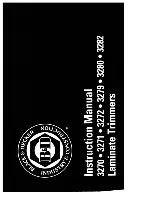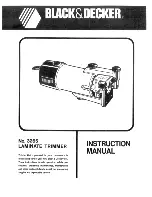
17
EN
■
Do not misuse the mains cable for carrying, suspending or unplugging the
power tool. Keep the mains cable away from heat, oil, sharp edges or moving
parts.
Damaged or entangled mains cables increase the risk of electric shock.
■
When operating a power tool outdoors, only use extension cables that are also
suitable for outdoor use.
Use of an extension cable that is suitable for outdoor use
reduces the risk of electric shock.
■
If operating the power tool in a damp location is unavoidable, use a residual
current device (RCD) protected supply.
Use of an RCD reduces the risk of electric
shock.
3) Personal Safety
■
Remain alert, pay attention to what you are doing, and use common sense
when operating a power tool. Do not use a power tool while you are tired or
under the infl uence of drugs, alcohol or medication.
A moment of inattention while
operating power tools may result in serious personal injury.
■
Wear personal protective equipment and always wear safety goggles.
Wearing
protective equipment such as a dust mask, non-skid safety shoes, hard hat, or hearing
protection used for appropriate conditions will reduce the risk of personal injury.
■
Avoid accidental start-up. Ensure that the power tool is switched off before
connecting it to the power supply and / or battery, picking up or carrying the
power tool.
Carrying power tools with your fi nger on the switch or energising power
tools that have the switch on invites accidents.
■
Remove any adjusting tools or wrenches before the power tool is switched on.
A tool or wrench left attached to a rotating part of the power tool may result in injuries.
■
Avoid adopting an abnormal posture. Maintain a secure footing, in particular
on slopes, and balance at all times. Walk, do not run.
This enables better control
of the power tool in unexpected situations.
■
Wear suitable clothing. Do not wear loose clothing or jewellery. Keep hair and
clothing away from moving parts.
Loose clothing, jewellery or long hair may become
entangled in moving parts.
■
If dust extraction and collection equipment can be mounted, it should be con-
nected and used properly.
Use of dust extraction can reduce dust-related hazards.
■
Do not have a false sense of security and do not ignore the safety rules for
power tools even if you are familiar with the power tool after using it many
times.
Careless actions can result in serious injuries in fractions of a second.
4) Power Tool Use and Care
■
Do not overload the power tool. Only ever use the designated power tool for
the activity that is to be performed.
With the appropriate power tool, you will work
better and more safely in the specifi ed power range.
■
Do not use a power tool whose switch is defective.
Any power tool that cannot be
controlled with the switch is dangerous and must be repaired.
■
Pull the mains plug out of the plug socket and / or remove a detachable battery
before any device settings are made, tool bits are changed or the power tool
is put to one side.
This preventive measure reduces the risk of starting the power tool
accidentally.
■
Store idle power tools out of the reach of children. Do not allow people who are
unfamiliar with the power tool or have not read these instructions to operate
the power tool.
Power tools are dangerous in the hands of inexperienced people.
















































